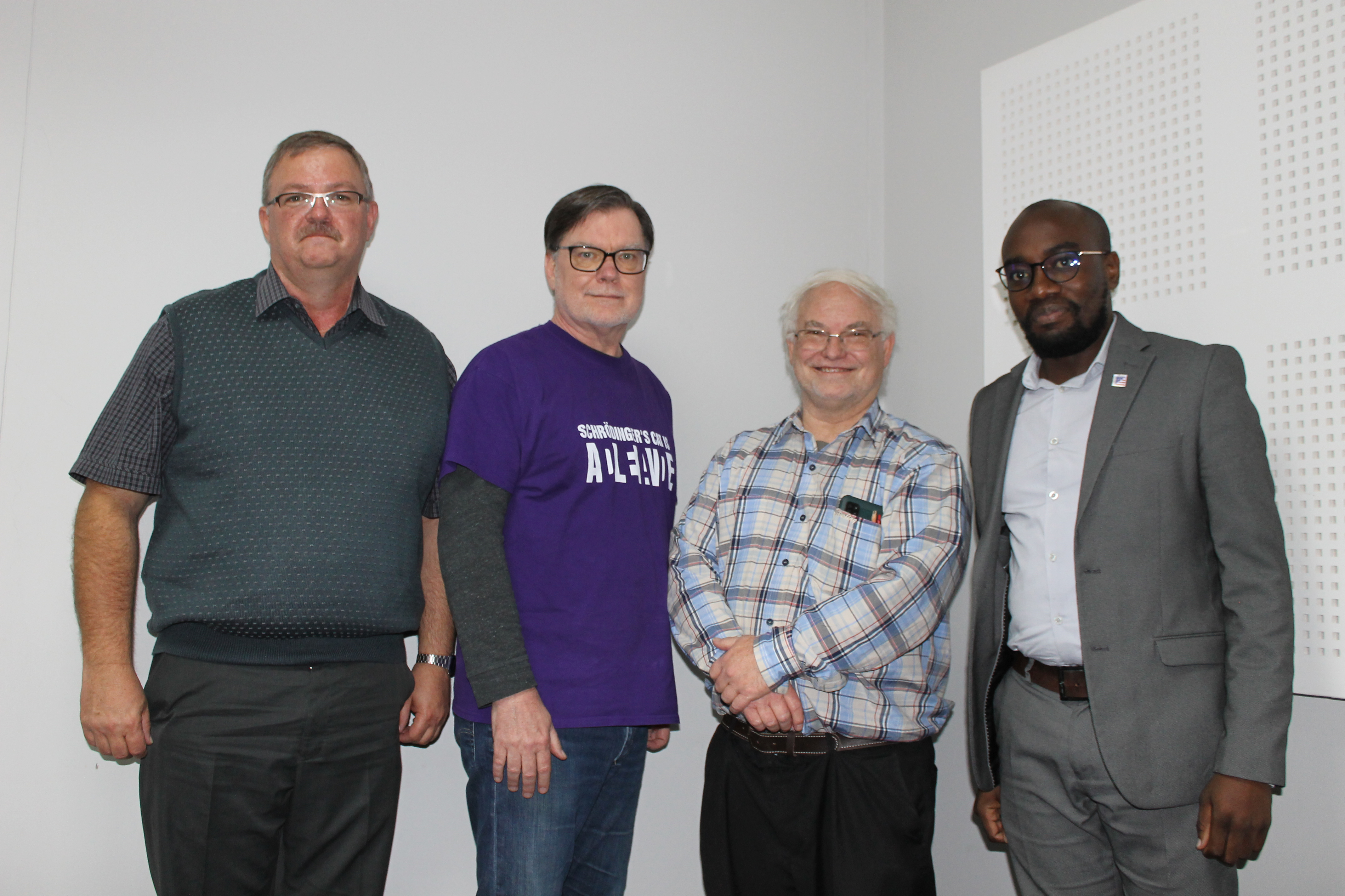02 June 2022
|
Story Leonie Bolleurs
|
Photo Leonie Bolleurs
 Prof Koos Terblans, Head of the Department of Physics; Jim Adams; Prof Matie Hoffman, Associate Professor in the Department of Physics; and Ernest Tshivhase from the office of the US Consul General in Johannesburg.
Prof Koos Terblans, Head of the Department of Physics; Jim Adams; Prof Matie Hoffman, Associate Professor in the Department of Physics; and Ernest Tshivhase from the office of the US Consul General in Johannesburg.
Who do you know who has designed rockets when they were children, and when grown up, is launching real-life rockets into space? “This just never gets old; does not matter how many rockets I have seen launched into space, it still is an amazing event to see that much power confined in such a tiny device,” says
Jim Adams,
NASA Deputy Chief Technologist (retired).
Adams has more than 35 years of aerospace experience and has been involved in more than 30 spaceflight missions to explore the earth, the sun, and most of our solar system. A group of Physics students and lecturers at the University of the Free State (UFS) recently had the opportunity to attend a lecture by Adams, speaking about the future of space exploration.
Finding answers in space
Included in Adams’ list of top space exploration missions are the Dragonfly mission, the Mars sample-return mission, and the Davinci+ and Veritas missions.
With the Dragonfly science mission scheduled to be launched in 2027, NASA scientists are working on flying a robotic quadcopter to the surface of Titan, the largest moon of Saturn, to collect data that they will use to obtain information on the formation of moons in the solar system. This will be the fourth mission in NASA’s New Frontiers portfolio, a series of investigator-led planetary science explorations.
By sending and collecting samples from Mars via the Mars sample-return mission, scientists are collecting rock samples and leaving them to be returned to earth later. A rocket will carry tubes filled with Martian soil and rock samples to the orbit around Mars, where it will be picked up by another spacecraft. The Perseverance rover successfully landed on Mars in 2021 and began its mission. Although Adams have foreseen risks in terms of landing – as two thirds of missions sent to Mars have failed in their descent into the planet’s thin atmosphere – the rover safely reached the surface. This mission puts NASA in the best position to getting samples back from Mars, in order to establish whether the planet holds any evidence of life. According to the Natural History Museum, Earth and Mars share a history within the solar system. If Mars were habitable, then it could at one point have had similar conditions as Earth in terms of harbouring life.
Adams also provided some insight into the Davinci+ and Veritas missions. NASA has selected these two new missions to understand how Venus, the nearest planet to Earth, became an inferno-like world, when it may have been the first habitable world in the solar system. The missions, which will shed some light on questions about climate change and global warming, are expected to launch between 2028 and 2030.
Reaching the stars, literally
Besides the opportunities to conduct research, space exploration missions now also offer humans the chance to ‘reach the stars’. According to Adams, space exploration is entering a new era, opening space to more people than only the global superpowers and trained astronauts. More private space companies delivering cargo in space, space flights for private citizens to visit the moon, and even space tourism services are not only possibilities but are becoming a reality. Adams adds that it is becoming more affordable to make use of these services.
Soon, operating from Kenia and other places in the world such as the Grand Canyon, the Great Barrier Reef, and the Great Pyramids of Egypt, World View will lift capsules in a six- to eight-hour ride to the edge of space, allowing humans to observe Earth from 37 km above the surface.
He says that human missions to Mars will also be possible before the end of the next decade, bringing with it job creation, research, and collaboration opportunities.
The benefit to everyday human living
Investing in space missions also greatly benefited humans. One example is the image sensor technology designed and developed for space, which is now being used in cellphone cameras worldwide. Another example is baby formulas that contain a seaweed-based nutritional enrichment ingredient, which was developed through NASA research to find a suitable nutritious agent for long-duration space travel. Space research is also used in nature research, with a star-mapping algorithm for the Hubble Space Telescope helping researchers to track the rare speckle-skinned whale shark.
“Investing in science and technology can work towards a better life on earth,” concludes Adams.
He also addressed members of the community at the Naval Hill Planetarium during an open evening event, on the topic: What happened to Mars? NASA’s Artemis Project to the Moon.